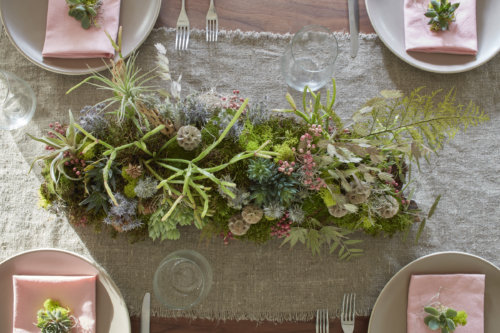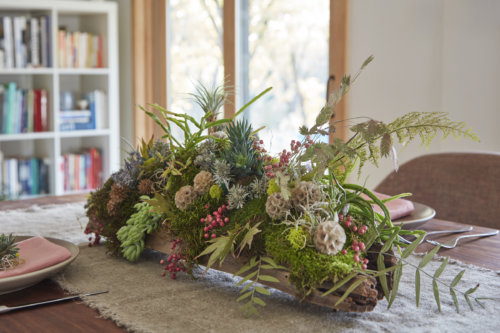
How To Make a Living Centerpiece
Last month we highlighted Caitlin Atkinson’s [easyazon_link identifier=”1604696494″ locale=”US” tag=”gardcoll03-20″]Plant Craft[/easyazon_link], an amazing resource full of green interior design DIYs that bring a modern botanic touch to the home. Below, she’s made an exclusive DIY for Garden Collage that’s perfect for the holidays. Check it out below!
Fall is my favorite time of year. In California, after a long dry summer, not only do the tree leaves change color, but dormant moss springs to life with the first rain, turning a rich green. A walk in the woods in early Autumn inspired this planted centerpiece. What better way to celebrate the seasonal change than with a woodland-inspired centerpiece? I opted for a base of live moss and succulents, then added a hint of pink and lavender from grasses, purple thistle, and California pepper berries that I dried. I also added pressed fern frond and maple leaves. (If you want more Fall color, swap out the pinks and lavenders for bright yellow gingko leaves, red maple leaves, and use bittersweet berries. Or make it a bit more wintery with pinecones and evergreens.)
For plants, I used haworthias and rhipsalis, as both do well indoors in bright light. You can substitute the succulents for different plants, but make sure to choose plants that do well indoors in bright, indirect light if you plan to keep the arrangement alive. You can choose to make the centerpiece temporary, just keeping it through the holidays, which will free up your choices. If you choose to make it temporary you can skip the first two steps. To care for the moss, mist it daily, keeping it moist. Water the plants with heavy misting, but let them dry out between waterings.
Materials
- 24″ x 6″ somewhat flat piece of wood (if using seawater driftwood, cure properly prior to use, which is done by soaking the driftwood for two weeks, changing out water periodically)
- Sphagnum moss– can be dried or fresh
- Potting mix
- Live moss
- 3 haworthias in 2″ or 4″ pots
- 1 sedum morganianum (burro’s tail) in 2″ or 4″ pot
- 2 rhipsalis in 2″ or 4″ pots
- 5 small tillandsias
- Dried botanicals (I used grasses, a pressed fern, pressed maple leaves, California pepper berries, scabiosa seed heads, and purple eryngium thistle.)
- 2-5 bamboo skewers cut down into 2-3 inch pieces (match the number of pieces to the number of tillandsias and dried seed heads and flowers).
- Hot glue or craft glue
- Floral wire
Directions
- Place a thin layer of sphagnum moss across the piece of wood.
- Place a thin layer of potting soil over the sphagnum moss.
- Loosen the plants from their plastic pots and loosen the soil and remove excess soil.
- Place the plants throughout the arrangement, nesting the plants into the wood. (I grouped two haworthias in the front left, a rhipsalis back left, a third haworthia toward the center, the burro’s tail sedum trailing toward the bottom front and a second rhipsalis back right.)
- Layer the moss over the soil, pressing it down over all exposed soil. Mix the different varieties to give texture and topography.
- Glue scabiosa seed heads and purple eryngium thistle onto the bamboo skewer pieces, once glue is dry insert skewer into moss so the head of the dried botanical sticks out.
- Wire the tillandsias individually to the skewer pieces by wrapping wire around the base set of leaves on the tillandsia and then wrap the wire securely around the bamboo skewer piece. Insert this into moss.
- Add the dried grass and fern frond by poking the stem into the moss.



































